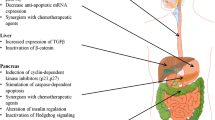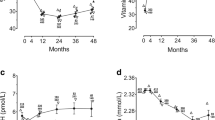Abstract
Background
To date, there are no studies reporting an association between vitamin D and Barrett’s esophagus (BE), the precursor for esophageal adenocarcinoma (EAC).
Aims
Our aim was to study the association between serum 25-hydroxyvitamin D (25(OH)D) levels and prevalence and incidence of dysplasia/EAC in BE.
Methods
Patients from our BE Registry cohort seen between 2000 and 2012 who had serum 25(OH)D levels measured were included. Age, gender, race, BE length, hiatal hernia size, and histological findings were recorded. Patients without high-grade dysplasia (HGD)/EAC at or within 1 year of index biopsy and who had follow-up endoscopies and 25(OH)D levels were studied for incidence of dysplasia/EAC.
Results
Among 429 patients with BE, the mean 25(OH)D level was 72 ± 31.2 nmol/L. Hundred and one (23.6 %) patients had deficiency (<50 nmol/L), 149 (34.7 %) had insufficiency (50–74.9 nmol/L), and 179 (41.7 %) had normal levels of 25(OH)D. There was no association between serum 25(OH)D levels and dysplasia (p = 0.90). In the incidence cohort of 246 patients with median follow-up of 46 months, there were 34 cases of low-grade dysplasia, 12 of HGD, and 5 of EAC. Change in 25(OH)D levels did not impact progression to dysplasia/EAC (every 5 nmol/L increase from baseline, hazard ratio 0.98; p = 0.62).
Conclusions
Serum 25(OH)D levels were low in 58.3 % of our BE cohort. There was no association between 25(OH)D levels and prevalence or incidence of HGD/EAC in patients with BE. Further long-term studies are needed to study the association between vitamin D status and progression of dysplasia in BE.



Similar content being viewed by others
References
Deeb KK, Trump DL, Johnson CS. Vitamin D signalling pathways in cancer: potential for anticancer therapeutics. Nature reviews. Cancer. 2007;7:684–700.
Diaz GD, Paraskeva C, Thomas MG, et al. Apoptosis is induced by the active metabolite of vitamin D3 and its analogue EB1089 in colorectal adenoma and carcinoma cells: possible implications for prevention and therapy. Cancer Res. 2000;60:2304–2312.
Holt PR, Arber N, Halmos B, et al. Colonic epithelial cell proliferation decreases with increasing levels of serum 25-hydroxy vitamin D. Cancer Epidemiol Biomark Prev. 2002;11:113–119.
Holt PR, Bresalier RS, Ma CK, et al. Calcium plus vitamin D alters preneoplastic features of colorectal adenomas and rectal mucosa. Cancer. 2006;106:287–296.
Trowbridge R, Kizer RT, Mittal SK, et al. 1,25-dihydroxyvitamin D in the pathogenesis of Barrett’s esophagus and esophageal adenocarcinoma. Expert Rev Clin Immunol. 2013;9:517–533.
Mulholland HG, Murray LJ, Anderson LA, et al. Vitamin D, calcium and dairy intake, and risk of oesophageal adenocarcinoma and its precursor conditions. Br J Nutr. 2011;106:732–741.
Tran B, Lucas R, Kimlin M, et al. Association between ambient ultraviolet radiation and risk of esophageal cancer. Am J Gastroenterol. 2012;107:1803–1813.
Food and Nutrition Board of the Institute of Medicine. Vitamin D. In: Young VR, Garza C, Atkinson SA, Munro IC, eds. Dietary Reference Intakes for Calcium, Phosphorus, Magnesium, Vitamin D, Fluoride. Washington, DC: National Academies Press; 1997:250.
Chung M, Lee J, Terasawa T, et al. Vitamin D with or without calcium supplementation for prevention of cancer and fractures: an updated meta-analysis for the U.S. Preventive Services Task Force. Ann Intern Med. 2011;155:827–838.
Garland CF, Garland FC. Do sunlight and vitamin D reduce the likelihood of colon cancer? Int J Epidemiol. 1980;9:227–231.
Fedirko V, Bostick RM, Goodman M, Flanders WD, Gross MD. Blood 25-hydroxyvitamin D3 concentrations and incident sporadic colorectal adenoma risk: a pooled case-control study. Am J Epidemiol. 2010;172:489–500.
Ebert R, Schutze N, Adamski J, et al. Vitamin D signaling is modulated on multiple levels in health and disease. Mol Cell Endocrinol. 2006;248:149–159.
Lamprecht SA, Lipkin M. Chemoprevention of colon cancer by calcium, vitamin D and folate: molecular mechanisms. Nature reviews. Cancer. 2003;3:601–614.
Ma Y, Zhang P, Wang F, Yang J, Liu Z, Qin H. Association between vitamin D and risk of colorectal cancer: a systematic review of prospective studies. J Clin Oncol. 2011;29:3775–3782.
Lee JE, Li H, Chan AT, et al. Circulating levels of vitamin D and colon and rectal cancer: the Physicians’ Health Study and a meta-analysis of prospective studies. Cancer Prev Res. 2011;4:735–743.
Maalmi H, Ordonez-Mena JM, Schottker B, Brenner H. Serum 25-hydroxyvitamin D levels and survival in colorectal and breast cancer patients: systematic review and meta-analysis of prospective cohort studies. Eur J Cancer. 2014;50:1510–1521.
La Vecchia C, Ferraroni M, D’Avanzo B, et al. Selected micronutrient intake and the risk of gastric cancer. Cancer Epidemiol Biomark Prev. 1994;3:393–398.
Pelucchi C, Tramacere I, Bertuccio P, et al. Dietary intake of selected micronutrients and gastric cancer risk: an Italian case-control study. Ann Oncol. 2009;20:160–165.
Chen W, Dawsey SM, Qiao YL, et al. Prospective study of serum 25(OH)-vitamin D concentration and risk of oesophageal and gastric cancers. Br J Cancer. 2007;97:123–128.
Abnet CC, Chen W, Dawsey SM, et al. Serum 25(OH)-vitamin D concentration and risk of esophageal squamous dysplasia. Cancer Epidemiol Biomark Prev. 2007;16:1889–1893.
Giovannucci E, Liu Y, Rimm EB, et al. Prospective study of predictors of vitamin D status and cancer incidence and mortality in men. J Natl Cancer Inst. 2006;98:451–459.
Boscoe FP, Schymura MJ. Solar ultraviolet-B exposure and cancer incidence and mortality in the United States, 1993–2002. BMC Cancer. 2006;6:264.
Chen W, Clements M, Rahman B, Zhang S, Qiao Y, Armstrong BK. Relationship between cancer mortality/incidence and ambient ultraviolet B irradiance in China. Cancer Causes Control. 2010;21:1701–1709.
Abnet CC, Chen Y, Chow WH, et al. Circulating 25-hydroxyvitamin D and risk of esophageal and gastric cancer: cohort consortium vitamin D pooling project of rarer cancers. Am J Epidemiol. 2010;172:94–106.
Cummings LC, Willis J, Cooper GS, et al. Effects of vitamin D supplementation on Barrett’s esophagus. Gastroenterology. 2013;144:s-696.
Hofmann JN, Yu K, Horst RL, et al. Long-term variation in serum 25-hydroxyvitamin D concentration among participants in the prostate, lung, colorectal, and ovarian cancer screening trial. Cancer Epidemiol Biomark Prev. 2010;19:927–931.
Author Contributions
Prashanthi N. Thota MD, FACG: Study design, data collection, data analysis and interpretation, and drafting the manuscript. Gaurav Kistangari MD, MPH: Data analysis and interpretation, and drafting the manuscript. Prabhdeep Singh, MD: Data collection and reviewing the manuscript. Linda Cummings, MD: Study design, data analysis and interpretation, and drafting the manuscript. Kaveh Hajifathalian, MD: Data Collection and reviewing the manuscript. Rocio Lopez MS: Study design, data analysis and interpretation, and reviewing the manuscript. Madhusudhan R. Sanaka MD, FACG: Study design, data analysis and interpretation, and reviewing the manuscript. The final draft submitted has been approved by all authors.
Author information
Authors and Affiliations
Corresponding author
Ethics declarations
Conflict of interest
None.
Guarantor of the Article
Prashanthi N. Thota, MD, FACG.
Rights and permissions
About this article
Cite this article
Thota, P.N., Kistangari, G., Singh, P. et al. Serum 25-Hydroxyvitamin D Levels and the Risk of Dysplasia and Esophageal Adenocarcinoma in Patients with Barrett’s Esophagus. Dig Dis Sci 61, 247–254 (2016). https://doi.org/10.1007/s10620-015-3823-5
Received:
Accepted:
Published:
Issue Date:
DOI: https://doi.org/10.1007/s10620-015-3823-5




